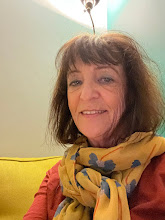 A detailed overview written by Jorge Daniel Veneciano, director at the Sheldon Museum of Art, is followed by the first essay from Sharon Kennedy, curator at the Sheldon. From the early 1900's in Europe to the United States, East and then West Coast, her presentation gives a historical perspective of the century old movement. The long list of references invites further reading.
A detailed overview written by Jorge Daniel Veneciano, director at the Sheldon Museum of Art, is followed by the first essay from Sharon Kennedy, curator at the Sheldon. From the early 1900's in Europe to the United States, East and then West Coast, her presentation gives a historical perspective of the century old movement. The long list of references invites further reading. Next, Jeremy Gilbert-Rolfe presents himself, a painter. His discussion is less disciplined and the dense text lost me at times. He introduces four artists, three of them females.
Next, Jeremy Gilbert-Rolfe presents himself, a painter. His discussion is less disciplined and the dense text lost me at times. He introduces four artists, three of them females.
The last essay is a masterpiece written by Veneciano. It brings abstract art to its next level, the search for the spiritual and the universal.
 Starting in the 60's with Ad Reinhardt, back and forth to Malevich, Kandinsky, Stella, Mondrian, the author explores the higher goals of geometric abstract and its search for purity. It is not an exercise but an ascese, which finds its roots in the occult. Joseph Steiner still influences artists like Olafur Eliasson or Tony Cragg . Veneciano brings us from the birth of geometric abstract, Cubism, to its shift from a spiritual to an intellectual quest as the movement travels West in the United States. His overall message is: "All modern abstract art functions as a catalyst for transcendent experience."
Starting in the 60's with Ad Reinhardt, back and forth to Malevich, Kandinsky, Stella, Mondrian, the author explores the higher goals of geometric abstract and its search for purity. It is not an exercise but an ascese, which finds its roots in the occult. Joseph Steiner still influences artists like Olafur Eliasson or Tony Cragg . Veneciano brings us from the birth of geometric abstract, Cubism, to its shift from a spiritual to an intellectual quest as the movement travels West in the United States. His overall message is: "All modern abstract art functions as a catalyst for transcendent experience."
 Starting in the 60's with Ad Reinhardt, back and forth to Malevich, Kandinsky, Stella, Mondrian, the author explores the higher goals of geometric abstract and its search for purity. It is not an exercise but an ascese, which finds its roots in the occult. Joseph Steiner still influences artists like Olafur Eliasson or Tony Cragg . Veneciano brings us from the birth of geometric abstract, Cubism, to its shift from a spiritual to an intellectual quest as the movement travels West in the United States. His overall message is: "All modern abstract art functions as a catalyst for transcendent experience."
Starting in the 60's with Ad Reinhardt, back and forth to Malevich, Kandinsky, Stella, Mondrian, the author explores the higher goals of geometric abstract and its search for purity. It is not an exercise but an ascese, which finds its roots in the occult. Joseph Steiner still influences artists like Olafur Eliasson or Tony Cragg . Veneciano brings us from the birth of geometric abstract, Cubism, to its shift from a spiritual to an intellectual quest as the movement travels West in the United States. His overall message is: "All modern abstract art functions as a catalyst for transcendent experience."
Abstract art may appear hermetic, because it is. It will help the reader to have some previous exposure to abstract to fully appreciate this book. At the end, one better understands the two pillars of abstract: geometry and unconscious.
"Kagu", Frank Stella, 1976
"Homage To The Square", Joseph Albers, 1965
"Throwback, Tony Smith, 1976-79


No comments:
Post a Comment